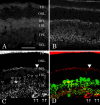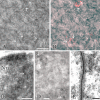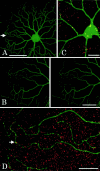Dendrodendritic electrical synapses between mammalian retinal ganglion cells
- PMID: 15548670
- PMCID: PMC6730298
- DOI: 10.1523/JNEUROSCI.3319-04.2004
Dendrodendritic electrical synapses between mammalian retinal ganglion cells
Abstract
Electrical synapses between alpha-type ganglion cells were detected using combined techniques of dual patch-clamp recordings, intracellular labeling, electron microscopy, and channel subunit connexin immunocytochemistry in the albino rat retina. After intracellular injection of Neurobiotin into alpha-cells of inner (ON-center) and outer (OFF-center) ramifying types, measurement of tracer coupling resulted in a preferentially homologous occurrence among cells of the same morphological type (n = 19 of 24). In high-voltage as well as conventional electron microscopic analysis, direct dendrodendritic gap junctions (average size, 0.86 mum long) were present in contact sites between tracer-coupled alpha-cells. In simultaneous dual whole-cell recordings from pairs of neighboring alpha-cells, these cells generated TTX-sensitive sustained spiking against extrinsic current injection, and bidirectional electrical synapses (maximum coupling coefficient, 0.32) with symmetrical junction conductance (average, 1.35 nS) were observed in pairs with cells of the same morphological type. Precise temporal synchronization of spike activity (average time delay, 2.7 msec) was detected when depolarizing currents were simultaneously injected into the pairs. To address whether physiologically identified electrical synapses constitute gap junctional connectivity between cell pairs, identified neuronal connexin36 immunoreactivity was undertaken in Lucifer yellow-labeled cell pairs after patch-clamp recordings. All alpha-cells expressed connexin36, and confocal laser-scanning imaging demonstrated that connexin36 is primarily located at dendritic crossings between electrically coupled cells (seven sites in a pair, on average). These results give conclusive evidence for electrical synapses via dendrodendritic gap junctions involving connexin36 in alpha retinal ganglion cells of the same physiological type.
Figures










Similar articles
-
Conflicting effects by antibodies against connexin36 during the action of intracellular Cyclic-AMP onto electrical synapses of retinal ganglion cells.J Integr Neurosci. 2016 Dec;15(4):571-591. doi: 10.1142/S021963521650031X. Epub 2017 Jan 4. J Integr Neurosci. 2016. PMID: 28052704
-
Structural and functional properties of homologous electrical synapses between retinal amacrine cells.J Integr Neurosci. 2005 Sep;4(3):313-40. doi: 10.1142/s0219635205000872. J Integr Neurosci. 2005. PMID: 16178061
-
Connexin36 is required for gap junctional coupling of most ganglion cell subtypes in the mouse retina.J Comp Neurol. 2010 Mar 15;518(6):911-27. doi: 10.1002/cne.22254. J Comp Neurol. 2010. PMID: 20058323 Free PMC article.
-
Gap junctional coupling in the vertebrate retina: variations on one theme?Prog Retin Eye Res. 2013 May;34:1-18. doi: 10.1016/j.preteyeres.2012.12.002. Epub 2013 Jan 8. Prog Retin Eye Res. 2013. PMID: 23313713 Review.
-
Electrical synapses in the mammalian brain.Annu Rev Neurosci. 2004;27:393-418. doi: 10.1146/annurev.neuro.26.041002.131128. Annu Rev Neurosci. 2004. PMID: 15217338 Review.
Cited by
-
Correlated firing among major ganglion cell types in primate retina.J Physiol. 2011 Jan 1;589(Pt 1):75-86. doi: 10.1113/jphysiol.2010.193888. Epub 2010 Oct 4. J Physiol. 2011. PMID: 20921200 Free PMC article.
-
The structure of multi-neuron firing patterns in primate retina.J Neurosci. 2006 Aug 9;26(32):8254-66. doi: 10.1523/JNEUROSCI.1282-06.2006. J Neurosci. 2006. PMID: 16899720 Free PMC article.
-
The structure of large-scale synchronized firing in primate retina.J Neurosci. 2009 Apr 15;29(15):5022-31. doi: 10.1523/JNEUROSCI.5187-08.2009. J Neurosci. 2009. PMID: 19369571 Free PMC article.
-
Gap junctions are essential for generating the correlated spike activity of neighboring retinal ganglion cells.PLoS One. 2013 Jul 23;8(7):e69426. doi: 10.1371/journal.pone.0069426. Print 2013. PLoS One. 2013. PMID: 23936012 Free PMC article.
-
Cellular composition and circuit organization of the locus coeruleus of adult mice.Elife. 2023 Feb 3;12:e80100. doi: 10.7554/eLife.80100. Elife. 2023. PMID: 36734517 Free PMC article.
References
-
- Adams JC (1981) Heavy metal intensification of DAB-based HRP reaction product. J Histochem Cytochem 29: 775. - PubMed
-
- Al-Ubaidi MR, White TW, Ripps H, Poras I, Avner P, Gomes D, Bruzzone R (2000) Functional properties, developmental regulation, and chromosomal localization of murine connexin36, a gap-junctional protein expressed preferentially in retina and brain. J Neurosci Res 59: 813-826. - PubMed
-
- Belluardo N, Mudo G, Trovato-Salinaro A, Le Gurun S, Charollais A, Beinier V, Amato G, Haefliger JA, Meda P, Condorelli DF (2000) Expression of connexin36 in the adult and developing rat brain. Brain Res 865: 121-138. - PubMed
Publication types
MeSH terms
Substances
LinkOut - more resources
Full Text Sources
Miscellaneous
